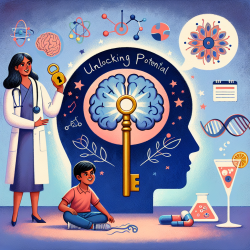Introduction
The mental health of youths in foster care is a pressing concern, with these individuals being particularly vulnerable to mood disorders due to their exposure to adverse childhood experiences (ACEs). The recent research article titled "Hard-to-treat or hard-to-catch? Clinical features and therapeutic outcomes of help-seeking foster care youths with mood disorders" provides valuable insights into the clinical features and therapeutic outcomes of this demographic. This blog will explore how practitioners can leverage these findings to improve therapeutic outcomes for foster care youths.
Understanding the Clinical Features
The study highlights the prevalence of mood disorders such as Disruptive Mood Dysregulation Disorder (DMDD) among foster care youths. These youths often exhibit chronic irritability and are more likely to have associated behavioral problems like substance misuse and running away. The research underscores the importance of recognizing these clinical features early to tailor interventions effectively.
Moreover, the study reveals a high incidence of neurodevelopmental disorders among foster care youths with mood disorders. These include intellectual development disorders and communication disorders, which can complicate the diagnosis and treatment of mood disorders. Practitioners should be vigilant in assessing these co-occurring conditions to provide comprehensive care.
Therapeutic Outcomes and Implications
One of the key findings of the research is that foster care youths do not inherently have a poorer prognosis compared to other inpatients when provided with appropriate therapeutic interventions. This challenges the notion of therapeutic defeatism often associated with treating this population. The study found no significant difference in the response to treatment during hospitalization between foster care youths and their peers.
However, the research indicates a higher rate of antipsychotic prescriptions among foster care youths, which calls for careful consideration of medication management. Practitioners should ensure that pharmacological treatments are complemented with evidence-based psychotherapies to address the unique needs of these youths.
Recommendations for Practitioners
- Comprehensive Assessment: Practitioners should conduct thorough assessments that consider the potential presence of neurodevelopmental disorders and ACEs. This will help in formulating a holistic treatment plan.
- Focus on Evidence-Based Interventions: Utilizing evidence-based therapies tailored to the specific needs of foster care youths can enhance therapeutic outcomes. This includes cognitive-behavioral therapies and interventions targeting emotional regulation.
- Collaborative Care Approach: Engaging multidisciplinary teams, including speech-language pathologists, can address the diverse needs of foster care youths, particularly those with communication disorders.
- Continuous Monitoring and Adjustment: Regularly monitoring treatment progress and adjusting interventions as needed can help in achieving better outcomes. Practitioners should be open to modifying treatment plans based on the evolving needs of the youth.
Encouraging Further Research
While the study provides valuable insights, it also highlights the need for further research to explore the long-term outcomes of therapeutic interventions for foster care youths. Practitioners are encouraged to contribute to this body of research by sharing their clinical experiences and outcomes.
To read the original research paper, please follow this link: Hard-to-treat or hard-to-catch? Clinical features and therapeutic outcomes of help-seeking foster care youths with mood disorders.










